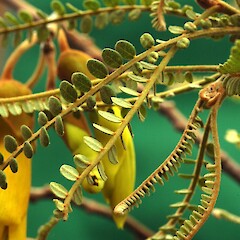Sophora godleyi
Common name
papa kōwhai, Godley’s kōwhai
Synonyms
None (described in 2001)
Family
Fabaceae
Flora category
Vascular – Native
Endemic taxon
Yes
Endemic genus
No
Endemic family
No
Structural class
Trees & Shrubs - Dicotyledons
Chromosome number
2n = 18
Current conservation status
The conservation status of all known New Zealand vascular plant taxa at the rank of species and below were reassessed in 2017 using the New Zealand Threat Classification System (NZTCS) – more information about this can be found on the NZTCS website. This report includes a statistical summary and brief notes on changes since 2012 and replaces all previous NZTCS lists for vascular plants.
Please note, threat classifications are often suggested by authors when publications fall between NZTCS assessment periods – an interim threat classification status has not been assessed by the NZTCS panel.
- Conservation status of New Zealand indigenous vascular plants, 2017 . 2018. Peter J. de Lange, Jeremy R. Rolfe, John W. Barkla, Shannel P. Courtney, Paul D. Champion, Leon R. Perrie, Sarah M. Beadel, Kerry A. Ford, Ilse Breitwieser, Ines Schönberger, Rowan Hindmarsh-Walls, Peter B. Heenan and Kate Ladley. Department of Conservation. Source: NZTCS and licensed by DOC for reuse under the Creative Commons Attribution 4.0 International licence.
2017 | Not Threatened
Previous conservation statuses
2012 | Not Threatened
2009 | Not Threatened
2004 | Not Threatened
Brief description
A weeping kowhai tree bearing leaves to 170mm long that have equal-sized yellowish-hairy leaflets 2-8mm long and with bunches of drooping yellow flowers and dry ridged and knobbly seed pods 60-120mm long containing hard yellow seeds. Juveniles with zig-zagging branches. Occurring in Central North Island.
Distribution
Endemic. New Zealand: North Island (in the west from Mokauiti River to the Manawatu)
Habitat
Mainly on limestone and calcareous mudstones, siltstones, and sandstones (Papa), and on alluvium derived from these parent materials. It has also been collected from old sand dunes in the vicinity of Bulls and Lake Alice
Detailed description
Small to large tree, often up to 25 m high, with 1 main trunk or several prominent main branches; main branches upright to spreading. Divaricating and/or strongly flexuose, juvenile branchlets absent; branchlets densely pubescent, becoming glabrous with age; hairs appressed, spreading or patent, predominantly curly, curved, or twisted, also straight. Seedlings and juveniles moderately to densely leafy, leaves with increasing numbers of leaflets. Leaflets on juveniles 6.0-9.0 × 3.5-6.0 mm, ovate, ± orbicular to elliptic, glabrous to sparsely pubescent, becoming moderately pubescent, not crowded or overlapping. Leaves on adults up to 170 mm long, imparipinnate, petioles and rachides channelled above, leaflets 47-75. Leaflets on adults 2.0-8.0 × 2.0-5.0 mm ovate to broadly elliptic sometimes ± orbicular, distal leaflets usually smaller than proximal leaflets, sometimes crowded but not overlapping, adaxial surface grey to green ; grey, abaxial surface lighter than adaxial surface and often concave; apices usually retuse to sometimes rounded; bases obtuse; petiolules up to 2 mm long, often only up to 0.5 mm long on leaflets < 3 mm long; petioles, rachides, petiolules, and leaflets usually pilose, sometimes villous, hairs 0.2-0.6 mm appressed, decumbent, spreading or patent, predominantly curly, curved, or twisted, but also straight. Inflorescences racemose, with up to 7 flowers; peduncle and rachis 20-40 mm long; pedicels up to 20 mm long, each subtended by a bract; bracts 1.5-3.5 mm long; peduncles, rachides, pedicels, bracts, and calyces moderately to densely pubescent; hairs brown appressed, decumbent, spreading, or patent. Calyx 9-13 × 10-16 mm, cupulate, rim shallowly lobed, with deeper notch adjacent to standard. Corolla yellow; keel petal blade 34-50 × 9-14 mm, wing petal blade 25-18 × 6-9 mm, standard petal blade 20-35 × 1 1-2 1 mm; petals with distinct claws, 5.0-6.5 mm long. Stipe 6-1 1 mm long, ± glabrous. Ovary 17-23 mm long, densely pubescent; hairs 0.4-0.7 mm long, off-white to light brown, appressed, spreading or patent, straight, curved or twisted. Style 12-14 mm long, exserted beyond anthers glabrous or with a few twisted hairs. Stigma fringed with short hairs. Filaments 25-40 mm long; anthers 1.8-2.0 × 0.9-1.0 mm. Fruit 60-120 mm long, 4-winged, brown, sparsely to moderately pubescent, with up to 11 seeds. Seeds 5-8 × 4-5 mm, oblong, yellow to yellow-brown.
Similar taxa
Distinguished from Sophora fulvida (Allan) Heenan et de Lange by the leaves which have 47-75 leaflets; by the ovate, broadly elliptic, to sometimes more or less orbicular leaflets, with a more or less distinct petiolule; by the leaflet hairs appressed, decumbent, spreading, or patent, predominantly curly, curved, or twisted; and restriction to the central North Island, where it grows on siltstone, sandstone, and mudstone (papa)
Flowering
October – December
Flower colours
Yellow
Fruiting
January - May
Propagation technique
Easy from seed. The hard seed coast should be lightly nicked or sanded and then soaked in water overnight before sowing to improve germination. Can be grown from cuttings but these are usually very slow and hard to strike.
Etymology
sophora: After the Arabic name for a similar tree
godleyi: Named after Eric John Godley (10 May 1919 – 27 June 2010[1]) OBE, FRSNZ, Hon FLS, Hon DSc (Cantuar.), AHRNZIH who was a New Zealand botanist and academic biographer.
Attribution
Description from Heenan et al. (2001).
References and further reading
Heenan, P.B.; de Lange, P.J.; Wilton, A.D. 2001: Sophora (Fabaceae) in New Zealand: taxonomy, distribution, and biogeography. New Zealand Journal of Botany, 39: 17-53
NZPCN Fact Sheet citation
Please cite as: de Lange, P.J. (Year at time of access): Sophora godleyi Fact Sheet (content continuously updated). New Zealand Plant Conservation Network. https://www.nzpcn.org.nz/flora/species/sophora-godleyi/ (Date website was queried)









